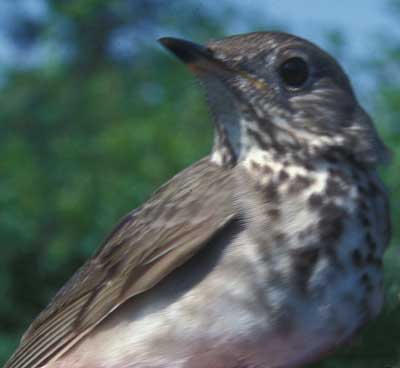The Gray-cheeked thrush has been proposed as a species for early detection of the Asian H5N1 virus in North America. In spring it migrates from wintering areas in South America to breeding sites across the boreal zone of North America. However, approximately 1.2 million birds migrate through Alaska and onto breeding areas in northeastern Siberia where they may become infected with Asian H5N1 through contact with infected birds that wintered in or migrated through areas with outbreaks in Asia. After breeding in Siberia, infected Gray-cheeked Thrushes would then migrate through Alaska thus carrying the virus to North America.
In Alaska, the Gray-cheeked Thrush is a common breeder and migrant in shrub habitats throughout Alaska where they co-occur with other Paleotropic migrants that rank high for surveillance of Asian H5N1, most notably Arctic Warbler (Phylloscopus borealis kennicotti). Adult and juvenile Gray-cheeked Thrushes are commonly captured in fall mist-netting efforts aimed at monitoring populations of terrestrial birds. For example, a total of approximately 100 individuals are captured annually during fall migration at monitoring stations currently operated in Denali National Park and Preserve (Alaska Natural History Institutes, Alaska Bird Observatory, National Park Service), Fairbanks (Alaska Bird Observatory), and Tok (U.S. Fish and Wildlife Service and Alaska Bird Observatory). Additionally, approximately 60 Gray-cheeked Thrushes were captured during fall migration in Bethel in 2000. Thus with a modest increase in existing effort, approximately 200 individual Gray-cheeked Thrushes could be captured and contribute to early surveillance of Asian H5N1 in North America in 2006.
We will capture a target sample of 200 fall staging Gray-cheeked Thrushes across 4 sampling stations in Alaska: Bethel, Denali National Park and Preserve, Fairbanks, and Tok. Stations in Denali, Fairbanks, and Tok will already be operated as part of ongoing monitoring programs. However, the re-establishment of previous migration monitoring stations in Bethel and an expanded effort in Denali will be needed to reach the target sample of 200 birds in 2006. An unknown proportion of these birds will have bred or been born in Siberia in 2006. At each station, birds will be captured from 20 July-30 September in arrays of 10-30 mist nets. Mist nets will be operated daily for a minimum of 6 hours, generally starting at sunrise; however, nets will be closed during periods of inclement weather. All captured Gray-cheeked Thrushes and Arctic Warblers will be will be aged, sexed, swabbed for actively shedding avian influenza virus, measured, banded, and released. Additionally, all other non-target species of birds captured in mist nets incidentally to work on Gray-cheeked Thrushes will be similarly handled; however, samples of fresh feces will be collected for virus screening rather than cloacal swabs. This will save considerable time when processing large numbers of birds at these stations. Personnel will follow the protocols of the National Wildlife Health Center (NWHC) to protect themselves from Asian H5N1 and to collect, store, and ship samples. Cloacal swabs will be sent to the NWHC for screening for Asian H5N1. Feces from non-target species will be stored by the U.S. Fish and Wildlife Service in Anchorage and will be made available to the NWHC for screening upon request. This work will be coordinated with other surveillance sampling of Gray-cheeked Thrushes and Arctic Warblers in Alaska.
No. of samples: 200 Gray-cheeked Thrushes (mixed adults and juveniles).
Sampling locations: Bethel, Denali, Fairbanks, Tok. Preference of sampling is 1) existing stations, 2) one new station in Bethel, 3) one new station in Denali, 4) second new station in Bethel.
Sampling timeframe: 20 July-30 September.
Sample demographics: Adults and juveniles, males and females.
Methods of capture: Live capture.
Other targeted species: Alder Flycatcher; Black-capped and Boreal chickadees; Arctic Warbler; Ruby-crowned Kinglet; Hermit, Swainson’s, and Varied thrushes; American Robin; Orange-crowned, Yellow-rumped, Blackpoll Yellow, and Wilson’s warblers; Northern Waterthrush; American tree, Savannah, Lincoln’s, Fox, and White-crowned sparrows; Dark-eyed Junco; Rusty Blackbird; Common and Hoary redpolls.
U.S. Fish and Wildlife Service
Migratory Bird Management
Contact: Steven M. Matsuoka
Tetlin NWR
Contact: Buddy Johnson
Yukon Delta NWR
Contact: Brian J. McCaffery
National Park Service
Denali National Park and Preserve
Contact: Carol McIntyre
Alaska Bird Observatory
Contact: David Shaw
Alaska Natural History Institutes
Contact: Kristin Siemann
None.


